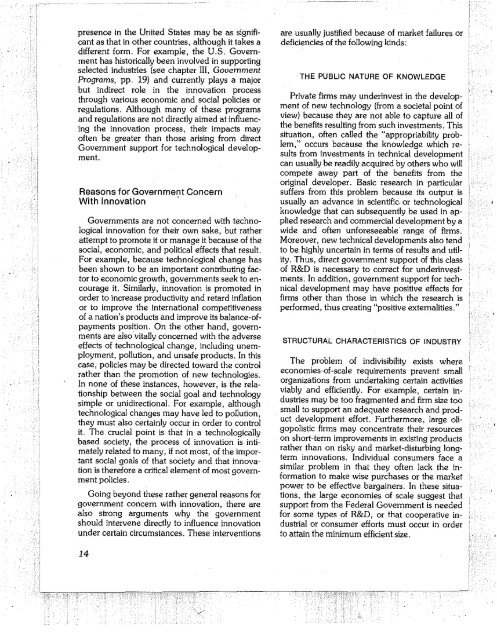Office of Technology Assessment - Bayhdolecentral
Office of Technology Assessment - Bayhdolecentral
Office of Technology Assessment - Bayhdolecentral
Create successful ePaper yourself
Turn your PDF publications into a flip-book with our unique Google optimized e-Paper software.
presence in the United States may be as significant<br />
as that in other countries, although it takes a<br />
different form. For example, the U.S. Government<br />
has historically been involved in supporting<br />
selected industries (see chapter III, Government<br />
Programs, pp. 19) and currently plays a major<br />
but indirect role in the innovation process<br />
through various economic and social policies or<br />
regulations. Although many <strong>of</strong> these programs<br />
and regulations are not directly aimed at influencing<br />
the innovation process, their impacts may<br />
<strong>of</strong>ten be greater than those arising from direct<br />
Government support for technological development.<br />
Reasons for Government Concern<br />
With Innovation .<br />
Governments are not concerned with technological<br />
innovation for their own sake, but rather<br />
attempt to promote it or manage it because <strong>of</strong> the<br />
social, economic, and political effects that result.<br />
For example, because technological change has<br />
been shown to be an important contributing factor<br />
to economic growth, governments seek to encourage<br />
it. Similarly, innovation is promoted in<br />
order to increase productivity and retard inflation<br />
or to improve the international competitiveness<br />
<strong>of</strong> a nation's products and improve its balance-<strong>of</strong>payments<br />
position. On the other hand, governments<br />
are alsovitally concerned with the adverse<br />
effects <strong>of</strong> technological change, including unemployment,<br />
pollution, and unsafe products. In this<br />
case, policies may be directed toward the control<br />
rather than the promotion <strong>of</strong> new technologies.<br />
In none <strong>of</strong> these instances, however, is the relationship<br />
between the social goal and technology<br />
simple or unidirectional. For example, although<br />
technological changes may have led to pollution,<br />
they must also certainly occur in order to control<br />
it. The crucial point is that in a technologically<br />
based society, the process <strong>of</strong> innovation is intimately<br />
related to many, if not most, <strong>of</strong> the important<br />
social goals <strong>of</strong> that society and that innovation<br />
is therefore a critical element <strong>of</strong> most government<br />
policies.<br />
Going beyond these rather general reasons for<br />
government concern with innovation, there are<br />
also strong arguments why the government<br />
should intervene directly to influence innovation<br />
under certain circumstances. These interventions<br />
14<br />
are usually justified because <strong>of</strong> market failures or<br />
deficiencies <strong>of</strong> the followlng kinds:<br />
THE PUBLIC NATURE OF KNOWLEDGE<br />
Private firms may underinvest in the development<br />
<strong>of</strong> new technology (from a societal point <strong>of</strong><br />
view) because they are not able to capture all <strong>of</strong><br />
the benefits resulting from such investments. This<br />
situation, <strong>of</strong>ten called the "appropriability problem,"<br />
occurs because the knowledge which results<br />
from investments in technical development<br />
can usually be readily acquired by others who will<br />
compete away part <strong>of</strong> the benefits from the<br />
original developer. Basic research in particular<br />
suffers from this problem because its output is<br />
usually an advance in scientific. or technological<br />
knowledge that can subsequently be used in applied<br />
research and commercial development by a<br />
wide and <strong>of</strong>ten unforeseeable range <strong>of</strong> firms.<br />
Moreover, new technical developments also tend<br />
to be highly uncertain in terms <strong>of</strong> results and utility.<br />
Thus, direct government support <strong>of</strong> this class<br />
<strong>of</strong> R&D is necessary to correct for underinvestments.<br />
In addition, government support for technical<br />
development may have positive effects for<br />
firms other than those in which the research is<br />
performed, thus creating "positive externalities."<br />
STRUCTURAL CHARACTERISTICS OF INDUSTRY<br />
The problem <strong>of</strong> indlvisibility exists where<br />
economies-<strong>of</strong>-scale requirements prevent small<br />
organizations from undertaking certain activities<br />
Viably and efficiently. For example, certain industries<br />
may be too fragmented and firm size too<br />
small to support an adequate research and product<br />
development effort. Furthermore, large oligopolistic<br />
firms may concentrate their resources<br />
on short-term improvements in existing products<br />
rather than on risky and market-disturbing longterm<br />
innovations. Individual consumers face a<br />
similar problem in that they <strong>of</strong>ten lack the information<br />
to make wise purchases or the market<br />
power to be effective bargainers. In these situations,<br />
the large economies <strong>of</strong> scale suggest that<br />
support from the Federal Government is needed<br />
for some types <strong>of</strong> R&D, or that cooperative industrial<br />
or consumer efforts must occur in order<br />
to attain the minimum efficient size.
















